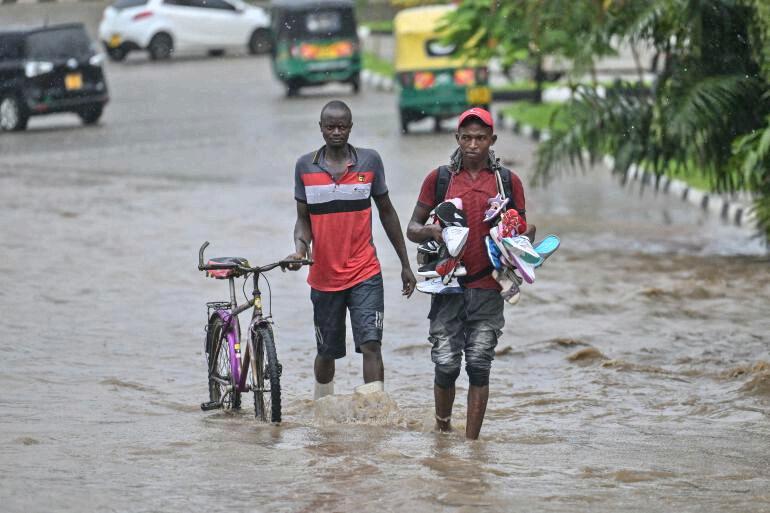
3 minute read
W A T E R
Flood: Impact and Readiness of Africa’s Road & Transportation Systems
AUTHOR: Chilombo (Olga) Priscila EconomicResearcher/Statistician@ RDJ Consulting
Advertisement
Courtesy:https://wwwaljazeeracom/news/2023/11/6/kenya-flooding-kills-15-displaces-thousands
Natural disasters are becoming more and more inevitable, taking a toll on livelihood’s and economies. Flooding in particular has become PedestrianswalkinafloodedstreetinthetownofNyali,afterheavyrainfallinMombasaonNovember3,2023[SimonMaina/AFP] more constant lately, impairing the serviceability of the transport system and causing disruption to mobility In fact, flooding incidents in cities across the world have exposed the vulnerability of transport networks which tends to result in significant, lasting disruptions.
Impact on Infrastructure, Mobility and Economy - Case studies
Flooding is well known to severely damage transportation infrastructure, including roads, bridges, and railways, while disrupting economic stability
In East Africa, for example, heavy rains and subsequent floods often result in road washouts and bridge collapses, cutting off communities and disrupting trade routes. A notable instance occurred in Kenya, where the 2019 floods caused extensive damage to the road network, isolating rural areas and hindering access to essential services Similarly, in West Africa, countries like Nigeria experience frequent flooding that inundates roads and impedes transportation. The 2012 floods in Nigeria affected over 30 states, destroying major highways and rural roads. The financial cost of repairing the damaged infrastructure was substantial, highlighting the economic burden posed by such natural disasters
The disruption of transportation due to flooding therefore has profound economic impacts. When transportation networks are compromised, the supply chain is disrupted, leading to shortages of essential goods and inflated prices Agricultural produce, which is crucial for both local consumption and export, often rots in the fields or fails to reach markets, affecting food security and farmers' incomes.
Additionally, communities are isolated facing delays in emergency response and healthcare services During the 2020 floods in South Sudan for instance, numerous communities were cut off, complicating efforts to deliver medical supplies and exacerbating the humanitarian crisis in the region
Tips on Readiness and Success Stories
To mitigate the impact of floods on transportation and mobility, several strategies have been proposed and implemented These include the construction of floodresistant infrastructure, improved drainage systems, and better urban planning. In addition, early warning systems and better weather forecasting play crucial roles in preparing for and responding to floods By providing timely information, these systems enable authorities to take preemptive measures, such as evacuating vulnerable areas and redirecting traffic, thus minimizing disruption and enhancing public safety.
Furthermore, the use of modern technologies and materials that resist flooding is highly recommended in the construction of roads and infrastructure so as to be ready for wet days These include the following:
Elevated Roadways and Bridges - Ethiopia
Elevating roadways and bridges are a common technique to prevent floodwaters from inundating transportation routes. By raising the road level above typical flood heights, these structures remain usable even during significant flooding events This is the case of Ethiopia, whose government (supported by the African Development Bank - AfDB), has invested in the Road Sector Support Project aimed at improving the resilience of its road network to flooding This entailed construction of elevated roads such as the Melkasa-Sodere-NuraeraMetehara road, and bridges designed to withstand flooding, as well as improving drainage systems to prevent waterlogging and erosion
Durable Materials - Kenya
Using durable, water-resistant materials is critical for constructing flood-resilient roads. Materials such as asphalt modified with polymers, concrete with additives that enhance water resistance, and geotextiles for soil stabilization help roads withstand prolonged exposure to water without significant deterioration An example of this is Kenya In response to frequent flooding, the Kenya National Highways Authority has also focused on constructing raised embankments and using durable, water-resistant materials for road surfaces. The integration of extensive drainage systems has also been a priority to ensure quick runoff of floodwaters and prevent road washouts.

Improved Drainage Systems - Mozambique
Effective drainage systems are essential for managing surface water and preventing water accumulation on roads These systems include culverts, ditches, and stormwater management facilities designed to handle large volumes of water quickly, reducing the risk of road damage and washouts. For this we can learn from Mozambique, who has rehabilitated its coastal road connecting Beira and Maputo after continuously being affected by cyclones This road has been elevated and reinforced with materials that withstand water damage, and extensive drainage systems have been installed to manage heavy rainfall.
Geotextiles and Reinforced Earth Structures
Geotextiles (like geotextiles and geomembranes) and reinforced earth structures are used to stabilize soil and prevent erosion, which is a common issue during floods These materials help maintain the integrity of road foundations and embankments, ensuring that roads remain passable even after heavy rains.

